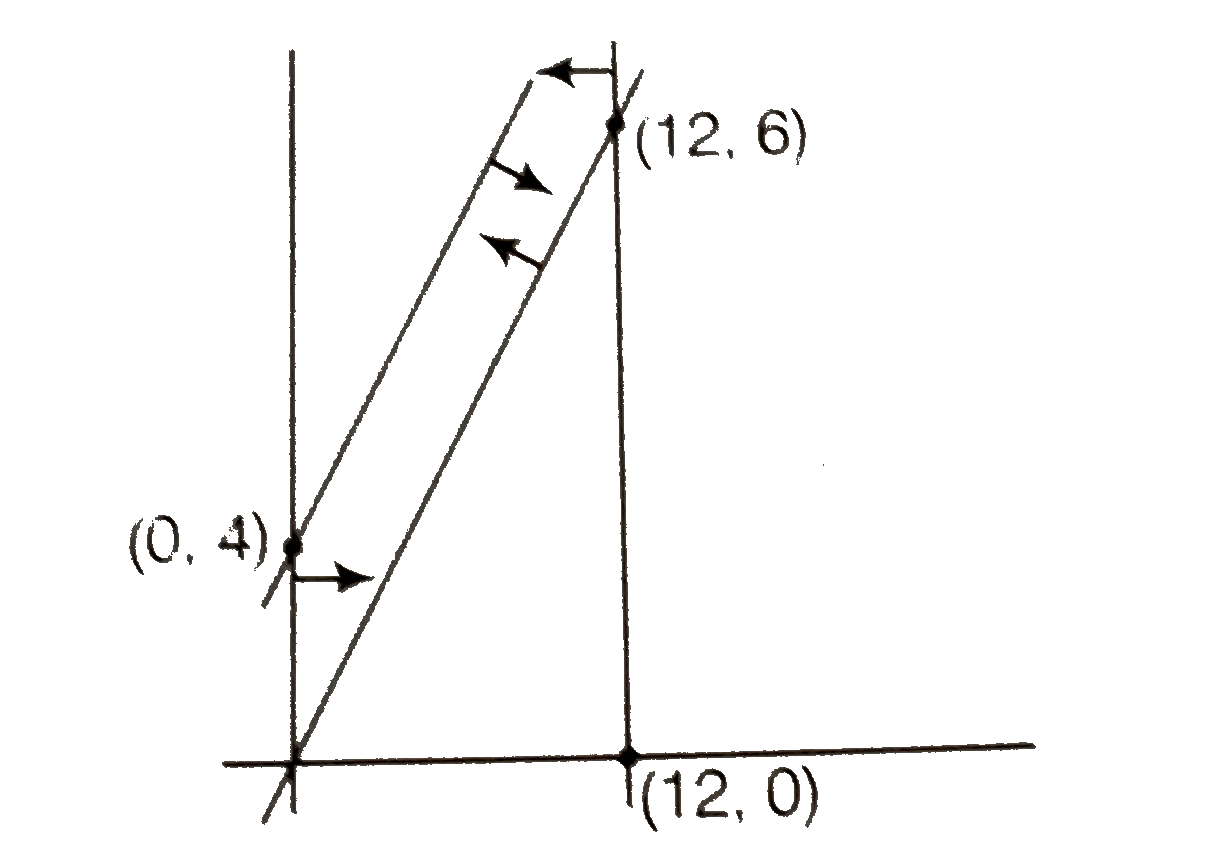Corner points of the feasible region for an LPP are (0,2), (3,0), (6,0), (6, 8) and (0,5).
Let F = 4x+6 y be the objective function.
The Minimum value of F occurs at Solution in Punjabi
(0, 2) only
(0, 3) only
the mid point of the line segment joining the points (0, 2) and (3,0) only
any point on the line segment joining the points (0, 2) and (3,0)
The correct Answer is:D
Step by step video, text & image solution for Corner points of the feasible region for an LPP are (0,2), (3,0), (6,0), (6, 8) and (0,5). Let F = 4x+6 y be the objective function. The Minimum value of F occurs at by Maths experts to help you in doubts & scoring excellent marks in Class 12 exams.
Updated on:21/07/2023Topper's Solved these Questions
- LINEAR PROGRAMMING BOOK - ACCURATE PUBLICATIONCHAPTER - LINEAR PROGRAMMING EXERCISE - QUESTIONS CARRYING 1 MARK (TYPE-II : FILL IN THE BLANKS QUESTIONS)
11 Videos
- LINEAR PROGRAMMING BOOK - ACCURATE PUBLICATIONCHAPTER - LINEAR PROGRAMMING EXERCISE - QUESTIONS CARRYING 1 MARK (TYPE-III : TRUE OR FALSE QUESTIONS)
10 Videos
- LINEAR PROGRAMMING BOOK - ACCURATE PUBLICATIONCHAPTER - LINEAR PROGRAMMING EXERCISE - QUESTIONS CARRYING 6 MARKS
7 Videos
- INVERSE TRIGONOMETRIC FUNCTIONSBOOK - ACCURATE PUBLICATIONCHAPTER - INVERSE TRIGONOMETRIC FUNCTIONSEXERCISE - QUESTIONS CARRYING 4 MARKS
27 Videos
- MATRICESBOOK - ACCURATE PUBLICATIONCHAPTER - MATRICESEXERCISE - QUESTIONS CARRYING 6 MARKS
4 Videos
Similar Questions
In a LPP, the linear inequalities or restrictions on the variables are called ..............
View SolutionIf the feasible region for a linear programming problem is bounded, then the objective function Z = ax+by has both a maximum and a minimum value on R.
View SolutionFind the maximum value of f = x+2 y subject to the constraints
2x+3y≤6
x+4y≤4
x,y≥0
View SolutionWrite the value of tan−1[2sin(2cos−1√32)].
View SolutionIf A=⎡⎢⎣1−202130−21⎤⎥⎦,B=⎡⎢⎣72−6−21−3−425⎤⎥⎦ , find AB Also solve x−2y=10,2x+y+3z=8,−2y+z=7
View SolutionCorner points of the feasible region for an LPP are (0,2),(3,0),(6,0),(6,8), and (0,5). Let F=4x+6y be the objective function. Determine the minimum value of F occurs at
View SolutionMaximum value of the objective function Z = ax +by in a LPP always occurs at only one corner point of the feasible region.
View SolutionConsider the following statements
I. If the feasible region of an LPP is undbounded then maximum or minimum value of the obJective function Z = ax + by may or may not exist .
II. Maximum value of the objective function Z = ax + by in an LPP always occurs at only one corner point of the feasible region.
Ill. In an LPP, the minimum value of the objective function Z = ax + by is always 0, if origin is one of the corner point of the feasible region.
IV. In an LPP, the maximum value of the objective function Z = ax + by is always finite.
Which of the following statements are true?
View Solutionकिसी LPP के सुसंगत क्षेत्र के कोणीय बिन्दु (0,2), (3,0), (6,0),(6,8) तथा (0,5) है | मान लीजिए कि F=4x+6y उद्देश्य फलन है | F का न्यूनतम मान किस बिन्दु पर है ?
View Solutionकिसी LPP के सुसंगत क्षेत्र के कोणीय बिन्दु (0,2), (3,0), (6,0),(6,8) तथा (0,5) है | मान लीजिए कि F=4x+6y उद्देश्य फलन है | F का अधिकतम मान −F का न्यूनतम मान बराबर है :
View SolutionThe feasible region for an LPP is shown in the following figure. Let F=3x−−4y be the objective function. Maximum value of F is

View SolutionCorner points of the feasible region for an LPP are (0,2),(3,0),(6,0),(6,8), and (0,5). Let F-4x+6y be the objective function. Determine the minimum valur of F occurs at
View SolutionMaximum value of the objective function Z = ax +by in a LPP always occurs at only one corner point of the feasible region.
View SolutionCorner points of the feasible region for an LPP are (0, 2), (3, 0), (6, 0), (6, 8) and (0, 5).
Let F = 4x + 6y be the objective function. (Maximum of F)-(Minimum of F) =
View SolutionMaximum value of the objective function Z = ax + by in a LPP always occurs at only one corner point of the feasible region.
View SolutionIn a LPP, the minimum value of the objective function Z = ax + by is always 0, if origin is one of the corner point of the feasible region.
View Solution
